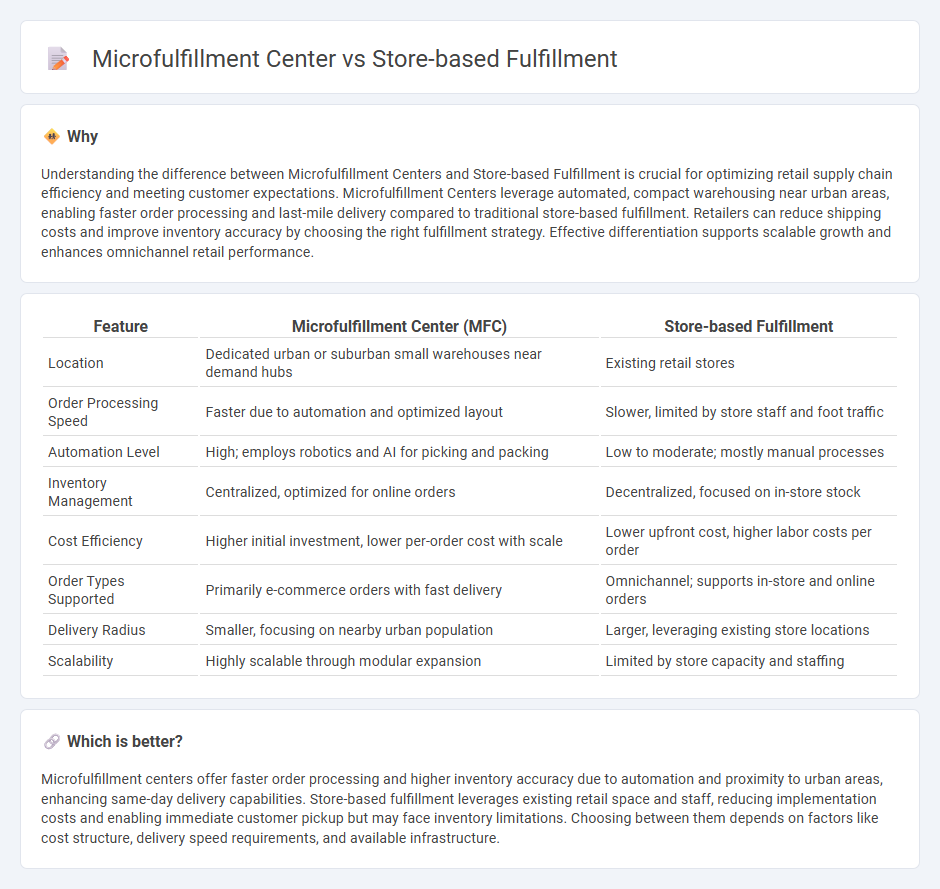
Microfulfillment centers leverage automation and proximity to urban areas to expedite order processing and reduce delivery times, while store-based fulfillment utilizes existing retail locations to fulfill online orders directly from inventory on hand. Microfulfillment centers are designed for scalability and efficiency, handling high order volumes with minimal human intervention, whereas store-based fulfillment relies on store staff and available space, often resulting in variable processing speeds. Explore how these fulfillment models impact retail supply chain strategies and customer satisfaction.
Why it is important
Understanding the difference between Microfulfillment Centers and Store-based Fulfillment is crucial for optimizing retail supply chain efficiency and meeting customer expectations. Microfulfillment Centers leverage automated, compact warehousing near urban areas, enabling faster order processing and last-mile delivery compared to traditional store-based fulfillment. Retailers can reduce shipping costs and improve inventory accuracy by choosing the right fulfillment strategy. Effective differentiation supports scalable growth and enhances omnichannel retail performance.
Comparison Table
| Feature | Microfulfillment Center (MFC) | Store-based Fulfillment |
|---|---|---|
| Location | Dedicated urban or suburban small warehouses near demand hubs | Existing retail stores |
| Order Processing Speed | Faster due to automation and optimized layout | Slower, limited by store staff and foot traffic |
| Automation Level | High; employs robotics and AI for picking and packing | Low to moderate; mostly manual processes |
| Inventory Management | Centralized, optimized for online orders | Decentralized, focused on in-store stock |
| Cost Efficiency | Higher initial investment, lower per-order cost with scale | Lower upfront cost, higher labor costs per order |
| Order Types Supported | Primarily e-commerce orders with fast delivery | Omnichannel; supports in-store and online orders |
| Delivery Radius | Smaller, focusing on nearby urban population | Larger, leveraging existing store locations |
| Scalability | Highly scalable through modular expansion | Limited by store capacity and staffing |
Which is better?
Microfulfillment centers offer faster order processing and higher inventory accuracy due to automation and proximity to urban areas, enhancing same-day delivery capabilities. Store-based fulfillment leverages existing retail space and staff, reducing implementation costs and enabling immediate customer pickup but may face inventory limitations. Choosing between them depends on factors like cost structure, delivery speed requirements, and available infrastructure.
Connection
Microfulfillment centers and store-based fulfillment are interconnected through shared inventory management systems that enable rapid order processing and local delivery. Retailers leverage microfulfillment centers to handle high volumes of online orders efficiently, while store-based fulfillment utilizes existing physical locations to expedite customer pickup and reduce last-mile delivery costs. This integrated approach enhances supply chain agility, improves inventory accuracy, and boosts customer satisfaction by reducing delivery times.
Key Terms
Inventory Management
Store-based fulfillment leverages existing retail locations to fulfill online orders, optimizing inventory by utilizing accurate in-store stock data to reduce stockouts and minimize transportation costs. Microfulfillment centers, often automated and strategically located near high-demand areas, enhance inventory turnover with faster replenishment cycles and precise real-time inventory tracking. Explore how these inventory management strategies can improve your fulfillment efficiency and customer satisfaction.
Order Picking Efficiency
Store-based fulfillment leverages existing retail locations to fulfill orders, which can streamline last-mile delivery but often faces challenges with limited space and mixed inventory, impacting order picking speed and accuracy. Microfulfillment centers, designed with automation and optimized layouts, significantly enhance order picking efficiency by reducing travel time and improving inventory accessibility, enabling quicker and more precise order processing. Explore how integrating microfulfillment strategies can elevate your supply chain performance and meet growing e-commerce demands.
Last-Mile Delivery
Store-based fulfillment leverages existing retail locations to expedite last-mile delivery by directly shipping products from stores, reducing delivery times and improving customer convenience. Microfulfillment centers are smaller, automated warehouses situated near urban areas designed to process online orders quickly, significantly enhancing delivery speed and inventory accuracy. Explore how these fulfillment strategies transform last-mile logistics for faster, more efficient customer service.
Source and External Links
Is ship from store fulfillment right for your retail business? - Ryder - Store-based fulfillment, known as ship from store, involves physical retail stores fulfilling and shipping online orders directly to customers by using in-store inventory, turning storefronts into omnichannel fulfillment centers.
Store fulfillment: Importance and 4 principles to utilize it in retail - Store fulfillment leverages brick-and-mortar stores as micro-fulfillment centers to deliver online orders, supporting models like ship from store, BOPIS, and curbside pickup for a flexible shopping experience.
In-Store Fulfillment - Deck Commerce - In-store fulfillment uses store inventory and staff to pick, pack, and ship orders locally, with smart order routing and centralized operations optimizing efficiency and customer convenience.
 dowidth.com
dowidth.com